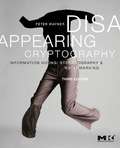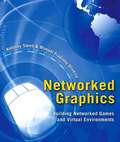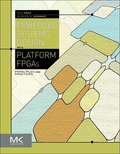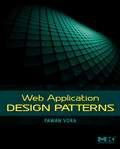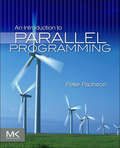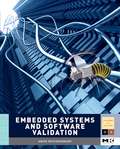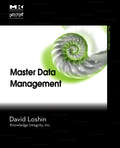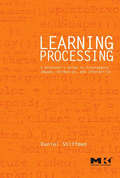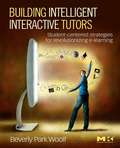- Table View
- List View
Programming Language Pragmatics
by Michael ScottProgramming Language Pragmatics, Third Edition, is the most comprehensive programming language book available today. Taking the perspective that language design and implementation are tightly interconnected and that neither can be fully understood in isolation, this critically acclaimed and bestselling book has been thoroughly updated to cover the most recent developments in programming language design, inclouding Java 6 and 7, C++0X, C# 3.0, F#, Fortran 2003 and 2008, Ada 2005, and Scheme R6RS. A new chapter on run-time program management covers virtual machines, managed code, just-in-time and dynamic compilation, reflection, binary translation and rewriting, mobile code, sandboxing, and debugging and program analysis tools. Over 800 numbered examples are provided to help the reader quickly cross-reference and access content. This text is designed for undergraduate Computer Science students, programmers, and systems and software engineers. Classic programming foundations text now updated to familiarize students with the languages they are most likely to encounter in the workforce, including including Java 7, C++, C# 3.0, F#, Fortran 2008, Ada 2005, Scheme R6RS, and Perl 6. New and expanded coverage of concurrency and run-time systems ensures students and professionals understand the most important advances driving software today. Includes over 800 numbered examples to help the reader quickly cross-reference and access content.
Architecture of Network Systems (ISSN)
by Dimitrios Serpanos Tilman WolfArchitecture of Network Systems explains the practice and methodologies that will allow you to solve a broad range of problems in system design, including problems related to security, quality of service, performance, manageability, and more. Leading researchers Dimitrios Serpanos and Tilman Wolf develop architectures for all network sub-systems, bridging the gap between operation and VLSI. This book provides comprehensive coverage of the technical aspects of network systems, including system-on-chip technologies, embedded protocol processing and high-performance, and low-power design. It develops a functional approach to network system architecture based on the OSI reference model, which is useful for practitioners at every level. It also covers both fundamentals and the latest developments in network systems architecture, including network-on-chip, network processors, algorithms for lookup and classification, and network systems for the next-generation Internet. The book is recommended for practicing engineers designing the architecture of network systems and graduate students in computer engineering and computer science studying network system design.This is the first book to provide comprehensive coverage of the technical aspects of network systems, including processing systems, hardware technologies, memory managers, software routers, and more. Develops a systematic approach to network architectures, based on the OSI reference model, that is useful for practitioners at every level. Covers both the important basics and cutting-edge topics in network systems architecture, including Quality of Service and Security for mobile, real-time P2P services, Low-Power Requirements for Mobile Systems, and next generation Internet systems.
Computer Organization and Design: The Hardware/Software Interface (ISSN)
by David A. Patterson John L. HennessyComputer Organization and Design, Fourth Edition, provides a new focus on the revolutionary change taking place in industry today: the switch from uniprocessor to multicore microprocessors. This new emphasis on parallelism is supported by updates reflecting the newest technologies with examples highlighting the latest processor designs, benchmarking standards, languages and tools. As with previous editions, a MIPS processor is the core used to present the fundamentals of hardware technologies, assembly language, computer arithmetic, pipelining, memory hierarchies and I/O. Along with its increased coverage of parallelism, this new edition offers new content on Flash memory and virtual machines as well as a new and important appendix written by industry experts covering the emergence and importance of the modern GPU (graphics processing unit), the highly parallel, highly multithreaded multiprocessor optimized for visual computing. This book contains a new exercise paradigm that allows instructors to reconfigure the 600 exercises included in the book to generate new exercises and solutions of their own. The companion CD provides a toolkit of simulators and compilers along with tutorials for using them as well as advanced content for further study and a search utility for finding content on the CD and in the printed text. This text is designed for professional digital system designers, programmers, application developers, and system software developers as well as undergraduate students in Computer Science, Computer Engineering and Electrical Engineering courses in Computer Organization, Computer Design.A new exercise paradigm allows instructors to reconfigure the 600 exercises included in the book to easily generate new exercises and solutions of their own. The companion CD provides a toolkit of simulators and compilers along with tutorials for using them, as well as advanced content for further study and a search utility for finding content on the CD and in the printed text. For the convenience of readers who have purchased an ebook edition or who may have misplaced the CD-ROM, all CD content is available as a download at http://bit.ly/12XinUx.
Disappearing Cryptography: Information Hiding: Steganography and Watermarking (The Morgan Kaufmann Series in Software Engineering and Programming)
by Peter WaynerCryptology is the practice of hiding digital information by means of various obfuscatory and steganographic techniques. The application of said techniques facilitates message confidentiality and sender/receiver identity authentication, and helps to ensure the integrity and security of computer passwords, ATM card information, digital signatures, DVD and HDDVD content, and electronic commerce. Cryptography is also central to digital rights management (DRM), a group of techniques for technologically controlling the use of copyrighted material that is being widely implemented and deployed at the behest of corporations that own and create revenue from the hundreds of thousands of mini-transactions that take place daily on programs like iTunes. This new edition of our best-selling book on cryptography and information hiding delineates a number of different methods to hide information in all types of digital media files. These methods include encryption, compression, data embedding and watermarking, data mimicry, and scrambling. During the last 5 years, the continued advancement and exponential increase of computer processing power have enhanced the efficacy and scope of electronic espionage and content appropriation. Therefore, this edition has amended and expanded outdated sections in accordance with new dangers, and includes 5 completely new chapters that introduce newer more sophisticated and refined cryptographic algorithms and techniques (such as fingerprinting, synchronization, and quantization) capable of withstanding the evolved forms of attack. Each chapter is divided into sections, first providing an introduction and high-level summary for those who wish to understand the concepts without wading through technical explanations, and then presenting concrete examples and greater detail for those who want to write their own programs. This combination of practicality and theory allows programmers and system designers to not only implement tried and true encryption procedures, but also consider probable future developments in their designs, thus fulfilling the need for preemptive caution that is becoming ever more explicit as the transference of digital media escalates.Includes 5 completely new chapters that delineate the most current and sophisticated cryptographic algorithms, allowing readers to protect their information against even the most evolved electronic attacksConceptual tutelage in conjunction with detailed mathematical directives allows the reader to not only understand encryption procedures, but also to write programs which anticipate future security developments in their design
Deploying QoS for Cisco IP and Next Generation Networks: The Definitive Guide
by Vinod Joseph Brett ChapmanDeploying QoS for IP Next Generation Networks: The Definitive Guide provides network architects and planners with insight into the various aspects that drive QoS deployment for the various network types. It serves as a single source of reference for businesses that plan to deploy a QoS framework for voice, video, mobility and data applications creating a converged infrastructure. It further provides detailed design and implementation details for various service deployments across the various Cisco platforms such as the CRS-1, 12000, 7600 & 7200 series routers that are widely deployed in most Carrier Networks. The book covers architectural and implementation specific information plus recommendations for almost all the popular line cards across the various hardware platforms widely used in the market. It also addresses QoS architecture and deployment on the Cisco CRS-1 platform and is considered as a unique selling point of this book. In short the books serve as an "On the Job Manual" which can also be used as a study guide for Cisco specialist certification programs (CCNA, CCIP, CCIE)This book will includes detailed illustration and configurations. In addition, it provides detailed case studies along with platform specific tests and measurement results. A link to a detailed tutorial on QoS metrics and associated test results will be available at the book's companion website in order to ensure that the reader is able to understand QoS functionality from a deployment standpoint.Covers the requirements and solutions in deploying QoS for voice, video, IPTV, mobility and data traffic classes (Quad-play networks), saving the reader time in searching for hardware specific QoS information, given the abundance of Cisco platforms and line cards.Presents real-life deployments by means of detailed case studies, allowing the reader to apply the same solutions to situations in the work place.Provides QoS architecture and implementation details on Cisco CRS-1, 12000, 7600, and 7200 routing platforms using Cisco IOS/IOS-XR software, aiding the reader in using these devices and preparing for Cisco specialist certification.
Networked Graphics: Building Networked Games and Virtual Environments
by Manuel Fradinho Oliveira Anthony SteedNetworked Graphics equips programmers and designers with a thorough grounding in the techniques used to create truly network-enabled computer graphics and games. Written for graphics/game/VE developers and students, it assumes no prior knowledge of networking. The text offers a broad view of what types of different architectural patterns can be found in current systems, and readers will learn the tradeoffs in achieving system requirements on the Internet. It explains the foundations of networked graphics, then explores real systems in depth, and finally considers standards and extensions. Numerous case studies and examples with working code are featured throughout the text, covering groundbreaking academic research and military simulation systems, as well as industry-leading game designs.Everything designers need to know when developing networked graphics and games is covered in one volume - no need to consult multiple sources.The many examples throughout the text feature real simulation code in C++ and Java that developers can use in their own design experiments.Case studies describing real-world systems show how requirements and constraints can be managed.
Broadband Cable Access Networks: The HFC Plant (ISSN)
by David Large James FarmerBroadband Cable Access Networks focuses on broadband distribution and systems architecture and concentrates on practical concepts that will allow the reader to do their own design, improvement, and troubleshooting work. The objective is to enhance the skill sets of a large population that designs and builds broadband cable plants, as well as those maintaining and troubleshooting it. A large cross-section of technical personnel who need to learn these skills design, maintain, and service HFC systems from signal creation through transmission to reception and processing at the customer end point. In addition, data/voice and video specialists need to master and reference the basics of HFC design and distribution before contending with the intricacies of their own unique services. This book serves as an essential reference to all cable engineers—those who specifically design and maintain the HFC distribution plant as well as those primarily concerned with data/voice technology as well as video technology.Concentrates on practical concepts that will allow the user to do his own design, improvement, and trouble-shooting work.Prepares cable engineers and technicians to work with assurance as they face the latest developments and future directions.Concise and tightly focused, allowing readers to easily find answers to questions about an idea or concept they are developing in this area.
Computer and Information Security Handbook
by John R. VaccaPresents information on how to analyze risks to your networks and the steps needed to select and deploy the appropriate countermeasures to reduce your exposure to physical and network threats. Also imparts the skills and knowledge needed to identify and counter some fundamental security risks and requirements, including Internet security threats and measures (audit trails IP sniffing/spoofing etc.) and how to implement security policies and procedures. In addition, this book covers security and network design with respect to particular vulnerabilities and threats. It also covers risk assessment and mitigation and auditing and testing of security systems as well as application standards and technologies required to build secure VPNs, configure client software and server operating systems, IPsec-enabled routers, firewalls and SSL clients. This comprehensive book will provide essential knowledge and skills needed to select, design and deploy a public key infrastructure (PKI) to secure existing and future applications.* Chapters contributed by leaders in the field cover theory and practice of computer security technology, allowing the reader to develop a new level of technical expertise* Comprehensive and up-to-date coverage of security issues facilitates learning and allows the reader to remain current and fully informed from multiple viewpoints* Presents methods of analysis and problem-solving techniques, enhancing the reader's grasp of the material and ability to implement practical solutions
Embedded Systems Design with Platform FPGAs: Principles and Practices
by Ronald Sass Andrew G. SchmidtEmbedded Systems Design with Platform FPGAs introduces professional engineers and students alike to system development using Platform FPGAs. The focus is on embedded systems but it also serves as a general guide to building custom computing systems. The text describes the fundamental technology in terms of hardware, software, and a set of principles to guide the development of Platform FPGA systems. The goal is to show how to systematically and creatively apply these principles to the construction of application-specific embedded system architectures. There is a strong focus on using free and open source software to increase productivity. Each chapter is organized into two parts. The white pages describe concepts, principles, and general knowledge. The gray pages provide a technical rendition of the main issues of the chapter and show the concepts applied in practice. This includes step-by-step details for a specific development board and tool chain so that the reader can carry out the same steps on their own. Rather than try to demonstrate the concepts on a broad set of tools and boards, the text uses a single set of tools (Xilinx Platform Studio, Linux, and GNU) throughout and uses a single developer board (Xilinx ML-510) for the examples.Explains how to use the Platform FPGA to meet complex design requirements and improve product performancePresents both fundamental concepts together with pragmatic, step-by-step instructions for building a system on a Platform FPGAIncludes detailed case studies, extended real-world examples, and lab exercises
Digital Evidence and Computer Crime: Forensic Science, Computers, and the Internet
by Eoghan CaseyDigital Evidence and Computer Crime, Third Edition, provides the knowledge necessary to uncover and use digital evidence effectively in any kind of investigation. It offers a thorough explanation of how computer networks function, how they can be involved in crimes, and how they can be used as a source of evidence. In particular, it addresses the abuse of computer networks as well as privacy and security issues on computer networks. This updated edition is organized into five parts. Part 1 is about digital forensics and covers topics ranging from the use of digital evidence in the courtroom to cybercrime law. Part 2 explores topics such as how digital investigations are conducted, handling a digital crime scene, and investigative reconstruction with digital evidence. Part 3 deals with apprehending offenders, whereas Part 4 focuses on the use of computers in digital investigation. The book concludes with Part 5, which includes the application of forensic science to networks. New to this edition are updated information on dedicated to networked Windows, Unix, and Macintosh computers, as well as Personal Digital Assistants; coverage of developments in related technology and tools; updated language for search warrant and coverage of legal developments in the US impacting computer forensics; and discussion of legislation from other countries to provide international scope. There are detailed case examples that demonstrate key concepts and give students a practical/applied understanding of the topics, along with ancillary materials that include an Instructor's Manual and PowerPoint slides. This book will prove valuable to computer forensic students and professionals, lawyers, law enforcement, and government agencies (IRS, FBI, CIA, CCIPS, etc.). Named The 2011 Best Digital Forensics Book by InfoSec ReviewsProvides a thorough explanation of how computers & networks function, how they can be involved in crimes, and how they can be used as evidence Features coverage of the abuse of computer networks and privacy and security issues on computer networks
Handbook of Digital Forensics and Investigation
by Eoghan CaseyHandbook of Digital Forensics and Investigation builds on the success of the Handbook of Computer Crime Investigation, bringing together renowned experts in all areas of digital forensics and investigation to provide the consummate resource for practitioners in the field. It is also designed as an accompanying text to Digital Evidence and Computer Crime. This unique collection details how to conduct digital investigations in both criminal and civil contexts, and how to locate and utilize digital evidence on computers, networks, and embedded systems. Specifically, the Investigative Methodology section of the Handbook provides expert guidance in the three main areas of practice: Forensic Analysis, Electronic Discovery, and Intrusion Investigation. The Technology section is extended and updated to reflect the state of the art in each area of specialization. The main areas of focus in the Technology section are forensic analysis of Windows, Unix, Macintosh, and embedded systems (including cellular telephones and other mobile devices), and investigations involving networks (including enterprise environments and mobile telecommunications technology). This handbook is an essential technical reference and on-the-job guide that IT professionals, forensic practitioners, law enforcement, and attorneys will rely on when confronted with computer related crime and digital evidence of any kind.*Provides methodologies proven in practice for conducting digital investigations of all kinds*Demonstrates how to locate and interpret a wide variety of digital evidence, and how it can be useful in investigations *Presents tools in the context of the investigative process, including EnCase, FTK, ProDiscover, foremost, XACT, Network Miner, Splunk, flow-tools, and many other specialized utilities and analysis platforms*Case examples in every chapter give readers a practical understanding of the technical, logistical, and legal challenges that arise in real investigations
Web Application Design Patterns (Interactive Technologies)
by Pawan VoraEver notice that—in spite of their pervasiveness—designing web applications is still challenging? While their benefits motivate their creation, there are no well-established guidelines for design. This often results in inconsistent behaviors and appearances, even among web applications created by the same company. Design patterns for web applications, similar in concept to those for web sites and software design, offer an effective solution. In Web Application Design Patterns, Pawan Vora documents design patterns for web applications by not only identifying design solutions for user interaction problems, but also by examining the rationale for their effectiveness, and by presenting how they should be applied.Design interfaces faster, with a better rationale for the solutions you choose.Learn from over more than 100 patterns, with extensive annotation on use and extension.Take a short-cut into understanding the industry with more than 500 full-color screenshots.
An Introduction to Parallel Programming
by Peter PachecoAn Introduction to Parallel Programming is the first undergraduate text to directly address compiling and running parallel programs on the new multi-core and cluster architecture. It explains how to design, debug, and evaluate the performance of distributed and shared-memory programs. The author Peter Pacheco uses a tutorial approach to show students how to develop effective parallel programs with MPI, Pthreads, and OpenMP, starting with small programming examples and building progressively to more challenging ones. The text is written for students in undergraduate parallel programming or parallel computing courses designed for the computer science major or as a service course to other departments; professionals with no background in parallel computing.Takes a tutorial approach, starting with small programming examples and building progressively to more challenging examplesFocuses on designing, debugging and evaluating the performance of distributed and shared-memory programsExplains how to develop parallel programs using MPI, Pthreads, and OpenMP programming models
Electronic Exchanges: The Global Transformation from Pits to Bits
by Michael Gorham Nidhi SinghAnyone reading the business section of a newspaper lately knows that the financial exchanges--stock, bonds, FX, commodities, and so forth--are undergoing tremendous transformations. Fund managers, market makers, traders, exchange professionals, marekt data providers and analyzers, investors--anyone involved with the financial exchanges needs to understand the major forces pushing this transformation in order to position themselves and their institutions to the best advantage.In this book, veteran exchange expert Michael Gorham joins his twenty-five years of experience with CME and CBOT to the technical expertise of Nidhi Singh of Goldman Sachs to write a book that tells the story of this dramatic transformation. They chronicle the shift:--from floors to screens--from private clubs to public companies, and--from local and national to global competition.They analyze each of these shifts, identify the drivers behind them and look forward to the implications arising out of them for exchange business in the future. They also explore several key trends:--an increase in product innovation--the integration of markets from all over the world onto a single screen,--the rise of the modular exchange--the outsourcing of various exchange functions, and--the difficulty of transcending geography for regulatory purposes.So join Gorham and Singh in learning the story of this fundamental transformation. As old ways of working are being destroyed, entirely new types of jobs are being created, and new ways of working with exchanges. This book will help you chart the way forward to financial success.*Gorham is an exchange expert and Singh is an electronic trading expert, they combine their expertise to reveal the inner workings of the exchanges and where they will go in the future*Only book to point to new skills needed and new ways of making money for users of exchange services
Embedded Systems and Software Validation
by Abhik RoychoudhuryModern embedded systems require high performance, low cost and low power consumption. Such systems typically consist of a heterogeneous collection of processors, specialized memory subsystems, and partially programmable or fixed-function components. This heterogeneity, coupled with issues such as hardware/software partitioning, mapping, scheduling, etc., leads to a large number of design possibilities, making performance debugging and validation of such systems a difficult problem. Embedded systems are used to control safety critical applications such as flight control, automotive electronics and healthcare monitoring. Clearly, developing reliable software/systems for such applications is of utmost importance. This book describes a host of debugging and verification methods which can help to achieve this goal.Covers the major abstraction levels of embedded systems design, starting from software analysis and micro-architectural modeling, to modeling of resource sharing and communication at the system levelIntegrates formal techniques of validation for hardware/software with debugging and validation of embedded system design flowsIncludes practical case studies to answer the questions: does a design meet its requirements, if not, then which parts of the system are responsible for the violation, and once they are identified, then how should the design be suitably modified?
Master Data Management (The MK/OMG Press)
by David LoshinThe key to a successful MDM initiative isn’t technology or methods, it’s people: the stakeholders in the organization and their complex ownership of the data that the initiative will affect.Master Data Management equips you with a deeply practical, business-focused way of thinking about MDM—an understanding that will greatly enhance your ability to communicate with stakeholders and win their support. Moreover, it will help you deserve their support: you’ll master all the details involved in planning and executing an MDM project that leads to measurable improvements in business productivity and effectiveness.* Presents a comprehensive roadmap that you can adapt to any MDM project.* Emphasizes the critical goal of maintaining and improving data quality.* Provides guidelines for determining which data to “master."* Examines special issues relating to master data metadata.* Considers a range of MDM architectural styles.* Covers the synchronization of master data across the application infrastructure.
P2P Networking and Applications
by Heather Yu John Buford Eng Keong LuaPeer-to-Peer (P2P) networks enable users to directly share digital content (such as audio, video, and text files) as well as real-time data (such as telephony traffic) with other users without depending on a central server. Although originally popularized by unlicensed online music services such as Napster, P2P networking has recently emerged as a viable multimillion dollar business model for the distribution of information, telecommunications, and social networking. Written at an accessible level for any reader familiar with fundamental Internet protocols, the book explains the conceptual operations and architecture underlying basic P2P systems using well-known commercial systems as models and also provides the means to improve upon these models with innovations that will better performance, security, and flexibility. Peer-to-Peer Networking and Applications is thus both a valuable starting point and an important reference to those practitioners employed by any of the 200 companies with approximately $400 million invested in this new and lucrative technology.Uses well-known commercial P2P systems as models, thus demonstrating real-world applicability.Discusses how current research trends in wireless networking, high-def content, DRM, etc. will intersect with P2P, allowing readers to account for future developments in their designs.Provides online access to the Overlay Weaver P2P emulator, an open-source tool that supports a number of peer-to-peer applications with which readers can practice.
Optical Networks: A Practical Perspective
by Rajiv Ramaswami Kumar Sivarajan Galen SasakiOptical Networks, Third Edition continues to be the authoritative source for information on optical networking technologies and techniques. Componentry and transmission are discussed in detail with emphasis on practical networking issues that affect organizations as they evaluate, deploy, or develop optical networks. New updates in this rapidly changing technology are introduced. These updates include sections on pluggable optical transceivers, ROADM (reconfigurable optical add/drop multiplexer), and electronic dispersion compensation. Current standards updates such as G.709 OTN, as well as, those for GPON, EPON, and BPON are featured. Expanded discussions on multimode fiber with additional sections on photonic crystal and plastic fibers, as well as expanded coverage of Ethernet and Multiprotocol Label Switching (MPLS). This book clearly explains all the hard-to-find information on architecture, control and management. It serves as your guide at every step of optical networking-- from planning to implementation through ongoing maintenance. This book is your key to thoroughly understanding practical optical networks. In-depth coverage of optimization, design, and management of the components and transmission of optical networksFilled with examples, figures, and problem sets to aid in development of dependable, speedy networksFocuses on practical, networking-specific issues: everything you need to know to implement currently available optical solutions
The Practitioner's Guide to Data Quality Improvement (The Morgan Kaufmann Series on Business Intelligence)
by David LoshinThe Practitioner's Guide to Data Quality Improvement offers a comprehensive look at data quality for business and IT, encompassing people, process, and technology. It shares the fundamentals for understanding the impacts of poor data quality, and guides practitioners and managers alike in socializing, gaining sponsorship for, planning, and establishing a data quality program. It demonstrates how to institute and run a data quality program, from first thoughts and justifications to maintenance and ongoing metrics. It includes an in-depth look at the use of data quality tools, including business case templates, and tools for analysis, reporting, and strategic planning. This book is recommended for data management practitioners, including database analysts, information analysts, data administrators, data architects, enterprise architects, data warehouse engineers, and systems analysts, and their managers.Offers a comprehensive look at data quality for business and IT, encompassing people, process, and technology. Shows how to institute and run a data quality program, from first thoughts and justifications to maintenance and ongoing metrics.Includes an in-depth look at the use of data quality tools, including business case templates, and tools for analysis, reporting, and strategic planning.
Technical, Commercial and Regulatory Challenges of QoS: An Internet Service Model Perspective (ISSN)
by XiPeng XiaoTechnical, Commerical and Regulatory Challenges of QoS provides a comprehensive examination of Internet QoS theory, standards, vendor implementation and network deployment from the practitioner's point of view, including extensive discussion of related economic and regulatory issues. Written in a technology-light way so that a variety of professionals and researchers in the information and networking industries can easily grasp the material. Includes case studies based on real-world experiences from industry. The author starts by discussing the economic, regulatory and technical challenges of the existing QoS model. Key coverage includes defining a clear business model for selling and buying QoS in relation to current and future direction of government regulation and QoS interoperability (or lack thereof) between carriers and networking devices. The author then demonstrates how to improve the current QoS model to create a clear selling point, less regulation uncertainty, and higher chance of deployment success. This includes discussion of QoS re-packaging to end-users; economic and regulatory benefits of the re-packaging; and the overall benefits of an improved technical approach. Finally, the author discusses the future evolution of QoS from an Internet philosophy perspective and lets the reader draw the conclusions. This book is the first QoS book to provide in depth coverage on the commercial and regulatory aspects of QoS, in addition to the technical aspect. From that, readers can grasp the commercial and regulatory issues of QoS and their implications on the overall QoS business model. This book is also the first QoS book to provide case studies of real world QoS deployments, contributed by the people who did the actual deployments. From that, readers can grasp the practical issues of QoS in real world. This book is also the first QoS book to cover both wireline QoS and wireless QoS. Readers can grasp the QoS issues in the wireless world. The book was reviewed and endorsed by a long list of prominent industrial and academic figures.Discusses QoS technology in relation to economic and regulatory issuesIncludes case studies based on real-world examples from industry practitionersProvides unique insight into how to improve the current QoS model to create a clear selling point, less regulatory uncertainty, and higher chance of deployment success
Learning Processing: A Beginner's Guide to Programming Images, Animation, and Interaction (The Morgan Kaufmann Series in Computer Graphics)
by Daniel ShiffmanThe free, open-source Processing programming language environment was created at MIT for people who want to develop images, animation, and sound. Based on the ubiquitous Java, it provides an alternative to daunting languages and expensive proprietary software. This book gives graphic designers, artists and illustrators of all stripes a jump start to working with processing by providing detailed information on the basic principles of programming with the language, followed by careful, step-by-step explanations of select advanced techniques.The author teaches computer graphics at NYU's Tisch School of the Arts, and his book has been developed with a supportive learning experience at its core. From algorithms and data mining to rendering and debugging, it teaches object-oriented programming from the ground up within the fascinating context of interactive visual media.Previously announced as "Pixels, Patterns, and Processing"*A guided journey from the very basics of computer programming through to creating custom interactive 3D graphics*Step-by-step examples, approachable language, exercises, and LOTS of sample code support the reader's learning curve*Includes lessons on how to program live video, animated images and interactive sound
Building Intelligent Interactive Tutors: Student-centered Strategies for Revolutionizing E-learning
by Beverly Park WoolfBuilding Intelligent Interactive Tutors discusses educational systems that assess a student's knowledge and are adaptive to a student's learning needs. The impact of computers has not been generally felt in education due to lack of hardware, teacher training, and sophisticated software. and because current instructional software is neither truly responsive to student needs nor flexible enough to emulate teaching. Dr. Woolf taps into 20 years of research on intelligent tutors to bring designers and developers a broad range of issues and methods that produce the best intelligent learning environments possible, whether for classroom or life-long learning. The book describes multidisciplinary approaches to using computers for teaching, reports on research, development, and real-world experiences, and discusses intelligent tutors, web-based learning systems, adaptive learning systems, intelligent agents and intelligent multimedia. It is recommended for professionals, graduate students, and others in computer science and educational technology who are developing online tutoring systems to support e-learning, and who want to build intelligence into the system.Combines both theory and practice to offer most in-depth and up-to-date treatment of intelligent tutoring systems availablePresents powerful drivers of virtual teaching systems, including cognitive science, artificial intelligence, and the InternetFeatures algorithmic material that enables programmers and researchers to design building components and intelligent systems
Heuristic Search: Theory and Applications
by Stefan Edelkamp Stefan SchroedlSearch has been vital to artificial intelligence from the very beginning as a core technique in problem solving. The authors present a thorough overview of heuristic search with a balance of discussion between theoretical analysis and efficient implementation and application to real-world problems. Current developments in search such as pattern databases and search with efficient use of external memory and parallel processing units on main boards and graphics cards are detailed. Heuristic search as a problem solving tool is demonstrated in applications for puzzle solving, game playing, constraint satisfaction and machine learning. While no previous familiarity with heuristic search is necessary the reader should have a basic knowledge of algorithms, data structures, and calculus. Real-world case studies and chapter ending exercises help to create a full and realized picture of how search fits into the world of artificial intelligence and the one around us.Provides real-world success stories and case studies for heuristic search algorithmsIncludes many AI developments not yet covered in textbooks such as pattern databases, symbolic search, and parallel processing units
Network Processors: Architecture, Programming, and Implementation (ISSN)
by Ran GiladiNetwork processors are the basic building blocks of today's high-speed, high-demand, quality-oriented communication networks. Designing and implementing network processors requires a new programming paradigm and an in-depth understanding of network processing requirements. This book leads the reader through the requirements and the underlying theory of networks, network processing, and network processors. It covers implementation of network processors and intergrates EZchip Microcode Development Environment so that you can gain hands-on experience in writing high-speed networking applications. By the end of the book, the reader will be able to write and test applications on a simulated network processor.Comprehensive, theoretical, and pracitical coverage of networks and high-speed networking applicationsDescirbes contemporary core, metro, and access networks and their processing algorithmsCovers network processor architectures and programming models, enabling readers to assess the optimal network processor typer and configuration for their applicationFree download from http://www.cse.bgu.ac.il/npbook includes microcode development tools that provide hands-on experience with programming a network processor
Probabilistic Methods for Bioinformatics: with an Introduction to Bayesian Networks
by Richard E. NeapolitanThe Bayesian network is one of the most important architectures for representing and reasoning with multivariate probability distributions. When used in conjunction with specialized informatics, possibilities of real-world applications are achieved. Probabilistic Methods for BioInformatics explains the application of probability and statistics, in particular Bayesian networks, to genetics. This book provides background material on probability, statistics, and genetics, and then moves on to discuss Bayesian networks and applications to bioinformatics. Rather than getting bogged down in proofs and algorithms, probabilistic methods used for biological information and Bayesian networks are explained in an accessible way using applications and case studies. The many useful applications of Bayesian networks that have been developed in the past 10 years are discussed. Forming a review of all the significant work in the field that will arguably become the most prevalent method in biological data analysis.Unique coverage of probabilistic reasoning methods applied to bioinformatics data--those methods that are likely to become the standard analysis tools for bioinformatics.Shares insights about when and why probabilistic methods can and cannot be used effectively; Complete review of Bayesian networks and probabilistic methods with a practical approach.



